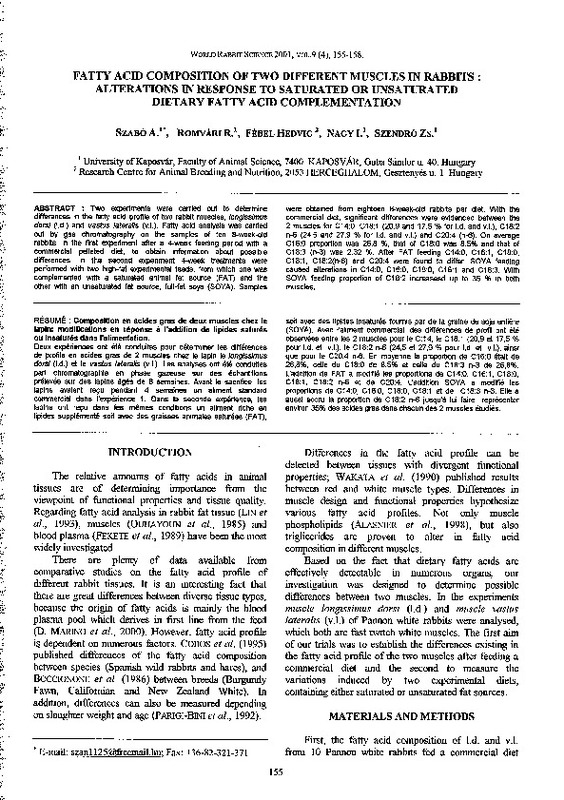JavaScript is disabled for your browser. Some features of this site may not work without it.
Buscar en RiuNet
Listar
Mi cuenta
Estadísticas
Ayuda RiuNet
Admin. UPV
FATTY ACID COMPOSITION OF TWO DIFFERENT MUSCLES IN RABBITS :ALTERATIONS IN RESPONSE TO SATURATED OR UNSATURATED DIETARY FATTY ACID COMPLEMENTATION
Mostrar el registro sencillo del ítem
Ficheros en el ítem
| dc.contributor.author | Szabó, A.
|
|
| dc.contributor.author | Romvári, R.
|
|
| dc.contributor.author | Fébel, H.
|
|
| dc.contributor.author | Nagy, I.
|
|
| dc.contributor.author | Szendrõ, ZS.
|
|
| dc.date.accessioned | 2011-02-24T14:17:26Z | |
| dc.date.available | 2011-02-24T14:17:26Z | |
| dc.date.issued | 2001 | |
| dc.identifier.issn | 1257-5011 | |
| dc.identifier.uri | http://hdl.handle.net/10251/10015 | |
| dc.description.abstract | [EN] Two experiments were carried out to determine differences in the fatty acid profile of two rabbit muscles, /ongissimus dorsi (l.d.) and vastus latera/is (v.I.). Fatty acid analysis was carried out by gas chromatography on the samples of ten 8-week-old rabbits, in the first experiment after a 4-week feeding period with a commercial pelleted diet, to obtain information about possible differences. In the second experiment 4-week treatments were performed with two high-fat experimental feeds, from which one was complemented with a saturated animal fat source (FAT) and the other with an unsaturated fat source, full-fat soya (SOYA). Samples were obtained from eighteen 8-week-old rabbits per diet. With the commercial diet, significant differences were evidenced between the 2 muscles for C14:0, C18:1 (20.9 and 17.5 % for l.d. and v.I.), C18:2 n-6 (24.5 and 27.9 % for l.d. and v.I.) and C20:4 (n-6). On average C16:0 proportion was 26.8 %, that of C18:0 was 8.5% and that of C18:3 (n-3) was 2.32 %. After FAT feeding C14:0, C16:1, C18:0, C18:1, C18:2(n-6) and C20:4 were found to differ. SOYA feeding caused alterations in C14:0, C16:0, C18:0, C18:1 and C18:3. With SOYA feeding proportion of C18:2 increasesd up to 35 % in both muscles. | es_ES |
| dc.description.abstract | [FR] Deux expériences ont été conduites pour déterminer les différences de profils en acides gras de 2 muscles chez le lapin le longissimus dorsi (l.d.) et le vastus latera/is (v.I.). Les analyses ont été conduites part chromatographie en phase gazeuse sur des échantillons prélevés sur des lapins agés de 8 semaines. Avant le sacrifice, les lapins avaient rec;:u pendant 4 semaines un aliment standard commercial dans l'expérience 1 . Dans la seconde expérience, les lapins ont rec;:u dans les memes conditions un aliment riche en lipides supplémenté soit avec des graisses animales saturées (FAT), soit avec des lipides insaturés foumis par de la graine de soja entiere (SOYA). Avec l'aliment commercial, des différences de profil ont été observées entre les 2 muscles pour le C:14, le C18:1 (20,9 et 17,5 % pour l.d. et v.I.), le C18:2 n-6 (24,5 et 27,9 % pour l.d. et v.I.), ainsi que pour le C20:4 n-6. En moyenne la proportion de C16:0 était de 26,8%, celle du C18:0 de 8,5% et celle du C18:3 n-3 de 26,8%. L'addition de FAT a modifié les proportions de C14:0, C16:1, C18:0, C18:1, C18:2 n-6 et de C20:4. L'addition SOYA a modifié les proportions de C14:0, C16:0, C18:0, C18:1 et de C18:3 n-3. Elle a aussi accru la proportion de C18:2 n-6 jusqu'a luí faire représenter environ 35% des acides gras dans chacun des 2 muscles étudiés. | |
| dc.language | Inglés | es_ES |
| dc.publisher | World Rabbit Science. ICTA. UPV | es_ES |
| dc.relation.ispartof | World Rabbit Science | |
| dc.rights | Reserva de todos los derechos | es_ES |
| dc.title | FATTY ACID COMPOSITION OF TWO DIFFERENT MUSCLES IN RABBITS :ALTERATIONS IN RESPONSE TO SATURATED OR UNSATURATED DIETARY FATTY ACID COMPLEMENTATION | es_ES |
| dc.type | Artículo | es_ES |
| dc.date.updated | 2011-02-24T14:11:32Z | |
| dc.identifier.doi | 10.4995/wrs.2001.459 | |
| dc.rights.accessRights | Abierto | es_ES |
| dc.description.bibliographicCitation | Szabó, A.; Romvári, R.; Fébel, H.; Nagy, I.; Szendrõ, Z. (2001). FATTY ACID COMPOSITION OF TWO DIFFERENT MUSCLES IN RABBITS :ALTERATIONS IN RESPONSE TO SATURATED OR UNSATURATED DIETARY FATTY ACID COMPLEMENTATION. World Rabbit Science. 9(4). https://doi.org/10.4995/wrs.2001.459 | es_ES |
| dc.description.accrualMethod | SWORD | es_ES |
| dc.relation.publisherversion | https://doi.org/10.4995/wrs.2001.459 | |
| dc.description.volume | 9 | |
| dc.description.issue | 4 | |
| dc.identifier.eissn | 1989-8886 | es_ES |








